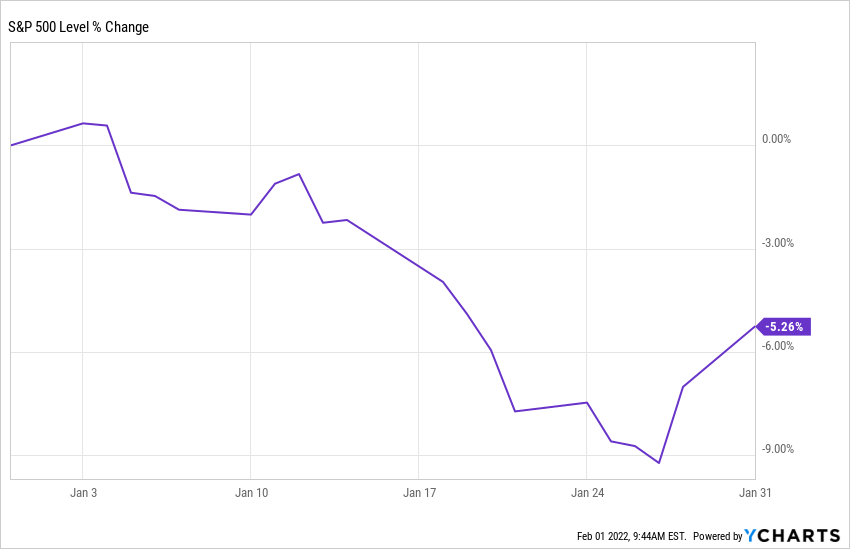Monthly Market Update
Submitted by TLWM Financial on February 1st, 2022
We hope that your year is off to a great start! The stock market has certainly kept us on our toes to start the year. January brought with it some volatility as stocks pulled back to begin the year, with the S&P 500 ending the month down about 5%. (YCharts)
In our annual outlook that we published late last year we highlighted a few key themes to watch including inflation and monetary policy. We didn’t have to wait long for these factors to impact markets as we saw the following developments:
- Monetary Policy: Expectations for the Federal Reserve to hike rates have increased with investors now expecting 4 rate hikes in ’22 (CME FedWatch Tool). Investors often worry that rate hikes mean the end is near for economic expansion. While it may be a signal that we are getting later in the economic cycle, stocks often do very well after the Fed begins hiking rates. Since 1958, stocks have taken an average of 3.4 years to reach a market peak after the first rate hike. (LPL Financial). This doesn’t mean that we’ll end up with the same outcome, but it shows us that a rate hike is not necessarily a reason to sell stocks.
- Inflation: Inflation data has continued on a similar path as we saw last year, and hasn’t done much to surprise investors so far this year. That said, we have seen wage inflation cited a number of times already in the Q4 earnings season. While this is good to see for many workers, it has the potential to put pressure on corporate earnings and will be a trend to watch throughout the year.
Our economic dashboard continues to signal that the chances of a recession in the near term are low. We have portfolios positioned for growth, but wouldn’t be surprised to see the recent volatility continue to be a theme throughout the year. We’ll be watching economic and market factors closely and will be ready to make adjustments to portfolios as needed.
Sincerely,
Your Team at TLWM
*Investment advice offered through TLWM, LLC., a registered investment advisor.
* The Standard & Poor's 500 (S&P 500) is an unmanaged group of securities considered to be representative of the stock market in general. You cannot invest directly in this index.
* The Standard & Poor’s 500 (S&P 500) is an unmanaged index. Unmanaged index returns do not reflect fees, expenses, or sales charges. Index performance is not indicative of the performance of any investment.
* The 10-year Treasury Note represents debt owed by the United States Treasury to the public. Since the U.S. Government is seen as a risk-free borrower, investors use the 10-year Treasury Note as a benchmark for the long-term bond market.
* Government bonds and Treasury Bills are guaranteed by the U.S. government as to the timely payment of principal and interest and, if held to maturity, offer a fixed rate of return and fixed principal value. However, the value of fund shares is not guaranteed and will fluctuate.
* Corporate bonds are considered higher risk than government bonds but normally offer a higher yield and are subject to market, interest rate and credit risk as well as additional risks based on the quality of issuer coupon rate, price, yield, maturity, and redemption features.
*Credit risk can be a factor in situations where an investment’s performance relies on a borrower’s repayment of borrowed funds. With credit risk, an investor can experience a loss or unfavorable performance if a borrower does not repay the borrowed funds as expected or required. Investment holdings that involve forms of indebtedness (i.e. borrowed funds) are subject to credit risk.
* Typically, the values of fixed-income securities change inversely with prevailing interest rates. Therefore, a fundamental risk of fixed-income securities is interest rate risk, which is the risk that their value will generally decline as prevailing interest rates rise, which may cause your account value to likewise decrease, and vice versa. How specific fixed income securities may react to changes in interest rates will depend on the specific characteristics of each security. Fixed-income securities are also subject to credit risk, prepayment risk, valuation risk, and liquidity risk. Credit risk is the chance that a bond issuer will fail to pay interest and principal in a timely manner, or that negative perceptions of the issuer’s ability to make such payments will cause the price of a bond to decline.
* Opinions expressed are subject to change without notice and are not intended as investment advice or to predict future performance.
* Economic forecasts set forth may not develop as predicted and there can be no guarantee that strategies promoted will be successful.
* Past performance does not guarantee future results. Investing involves risk, including loss of principal.
* You cannot invest directly in an index.
* Consult your financial professional before making any investment decision.
* Stock investing involves risk including loss of principal.
* This document is solely for informational purposes. Advisory services are only offered to clients or prospective clients where Texas Legacy Wealth Management and its representatives are properly licensed or exempt from licensure.
* No strategy ensures a profit or protects against a loss.

